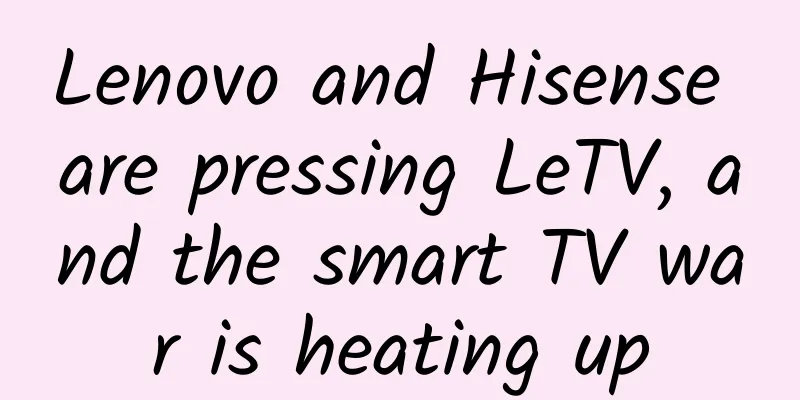Lenovo and Hisense are pressing LeTV, and the smart TV war is heating up

|
The fierce competition in the smart TV market has never stopped, and today, a new round of arms race has begun. On March 27, Lenovo's new generation 4K smart TV S9 was launched. This is a collaboration with NVIDIA. The chip is extremely powerful, pushing the hardware of smart TV to a new height. Before that, on March 18, Hisense signed contracts with 11 video websites including Future TV, iQiyi PPS, Phoenix Video, Ku6 , LeTV, LeKan, PPTV, Sohu Video, Youku Tudou, and Youpeng to share Internet video content through Hisense TV. Obviously, the competition in smart TV is multi-dimensional, whether it is the TV hardware itself or the TV content, it is full of strong gunpowder. Smart TVs have been developing day by day. In this year's fierce competition, TV manufacturers have changed their strategy: based on the integration of software and hardware, they have further refined the two paths of software and hardware. Will they focus on hardware advantages or integrate all websites and play the card of content? This is the new choice. Three major paths of Lenovo, Hisense and LeTV The Internet has brought more imagination to television, and the broad market prospects are the basic desire of many businesses to enter the field of smart TV. In 2014, which was predicted to be the outbreak node of smart TV, the smoke of war filled the air, and traditional TV manufacturers and Internet companies flocked to the market. The competition between them was inevitable. Lenovo, which is in the PC field, changed its low-key approach in the field of smart TV and started to compete directly with LeTV. On March 27, Lenovo's new generation of smart TV S9 was launched, and this TV was named "Terminator". It is mainly reflected in the product appearance and performance. The appearance has changed from the previous black tone, and this product first proposed the concept of "one card upgrade" for smart TV. As we all know, the usage cycle of TV is longer than that of smartphones. Therefore, people have a fear of "outdated" consumption of smart TVs, and the launch of Lenovo S9 solves this problem. Ren Zhongwei, general manager of Lenovo Group's smart TV business unit in China, said in an interview with the Times Weekly reporter that Lenovo launched the "one-card upgrade" technology based on its deep insight into user needs, hardware replacement rhythm, content development, etc., which can simultaneously achieve dual upgrades of software and hardware, making smart TVs "never out of date." In Lenovo's view, hardware itself is the prerequisite for smart TVs to gain market recognition. In addition, in building content platforms, Lenovo is also accelerating cooperation with content websites. But overall, Lenovo's hardware advantages are more prominent. Another approach in the field of smart TVs is to focus on "software". On March 18, traditional TV manufacturer Hisense teamed up with 11 video websites to launch smart TV content and create an integrated platform. In other words, 12 companies worked together to achieve the largest range of Internet video content sharing, and Hisense TV will provide this terminal platform. It is a good thing for traditional TV companies to join hands with video companies to share resources and learn from each other's strengths and overcome their weaknesses, but in the long run, the lack of content will be a major pain point for them. Internet commentator Hong Bo believes that Hisense's approach marks the complete integration of the Internet and television. Perhaps it is the traditional television companies that are jealous, while it is the Internet "disruptors" that are embarrassed. However, analysts have expressed different views on Hisense's "big aggregation" approach of cooperating with 11 video websites at once: cooperating with one video website is a win-win situation, but cooperating with 11 websites seems to be an aggregation and a platform, but in fact, this is just wishful thinking. Hisense seems to have easily obtained a "content pool" with massive resources, but in fact, this move has put it in a passive position. For example, the TVs that Hisense has worked hard to sell are likely to become content channels for others. In addition, in the future, it will surely make it difficult for Hisense to choose and display film sources. After all, there are 11 partners, and it is indeed a problem whose content to use first. Compared with Hisense's desperate approach, Internet companies are more flexible. LeTV, which considers itself a "disruptor", focuses on building an ecosystem. LeTV TV has created a complete LeTV ecosystem of "platform + content + terminal + application". Users buy not only a TV, but also a full value chain service of the large-screen Internet. In addition to the periodic optimization and upgrade of the UI system, the continuous update of high-quality content is used to create the ultimate user experience. Whether soft or hard, smart TV companies have different strategic focuses. In this regard, Liu Jinyu, an observer of the home appliance industry, said that the hardware of smart TVs is basically settled and will soon usher in a window period. As for TV content, which is the back-end power of smart TVs, the current gaming industry may be a good direction. Entertainment moves towards computers and mobile phones In 2014, Jack Ma, who claimed that he would rather die than make games , broke his promise and started to make mobile game platforms. You can imagine how popular games are, but will TV games become popular? At present, all smart TV manufacturers are waiting for a breakthrough point. Huang Xun, a gaming industry observer, believes that good games are basically region-neutral for players. PC games and mobile games are both viable platforms, but running games on smart TVs requires fast running speeds to ensure user experience. It is true that players in the PC era were most concerned about the configuration of the computer. When it comes to mobile games, the focus has shifted to the configuration of the mobile phone. The previous mobile phone "nuclear war" was launched against game players. In fact, there is also "nuclear war" on smart TVs. Ren Zhongwei said that S9 can allow consumers to upgrade the hardware and software comprehensively without changing the TV through the hardware smart upgrade card. The hardware upgrade card uses NVIDIA's latest Tegra K1 processing chip, which is one step ahead in basic performance and graphics processing capabilities. With this feature, Lenovo hopes to build smart TV into a new gaming platform. From PC to mobile games, and now to smart TVs. It cannot be ignored that the number of smart TV users and the performance of the TV itself are two factors that cannot be ignored. They restrict the development of games on smart TVs. Lenovo hopes to solve the TV performance limitations of TV games through the "upgradability" of hardware capabilities. Not only that, Lenovo also cooperates with game production companies to jointly launch TV games, and jointly creates an ecosystem for smart TV games through its own Le Store and more open game platforms, especially in the field of home games. For TV manufacturers, investment in games belongs to the content part, and it has no advantages for traditional TV manufacturers such as Hisense. It is obvious that Internet companies like Lenovo and LeTV are no strangers to games. At the same time, this is a problem that traditional TV manufacturers need to face and solve. New Three Kingdoms: Turning to the Internet Model The bravest will win when two meet on a narrow road. After the market competition in the past year, major TV manufacturers have ushered in a new round of "route competition", either focusing on hardware advantages, or "content alliance", or opening up new market space with TV games. But among the three types of companies represented by Lenovo, LeTV, and Hisense, who can truly win? It doesn’t matter whether TV manufacturers’ investment in hardware and content is fair or not; everything will be tested by the market. For commercial transactions, if the hardware itself is not too different, the rest is the corporate image and sales channels. On April 8, Lenovo Smart TV S9 has started to be pre-ordered for public testing, priced at 3,499 yuan. On April 16, S9 will be officially available for sale on Yixun, JD.com, Suning.com, Tmall and its own e-commerce platform. In addition, Lenovo has begun to build O2O TV sales channels, where consumers in first-, second- and third-tier markets can purchase directly through online channels, and Lenovo will deliver directly to these areas. In fourth-, fifth- and sixth-tier markets, Lenovo will use smart TV stores and Lenovo's PC store network to complete the "last mile" of e-commerce. LeTV has quickly stepped into the spotlight with the power of Internet marketing, gradually surpassing the pace of traditional TVs, and has achieved quite good results through online sales. Not long ago, 10,000 S50s were officially released, setting an industry record of 9 minutes and 19 seconds. Observers said that this is the Internet era, which would be unimaginable in any previous era. Traditional companies cannot do this. It is undeniable that the limitations of the times are also a pain for traditional TV companies. Old TV manufacturers such as Hisense and Changhong have a deep understanding of the TV industry and their brand image has a good reputation. However, in today's Internet era, how to play Internet thinking well still needs to be learned. The Internet gameplay that seems to be content aggregation, if not played well, will turn its advantages into disadvantages. In terms of the business model change towards the Internet, although Lenovo is a veteran enterprise, its transformation direction is more "Internet-oriented" based on the concept of PC and mobile phones. In the interview, when talking about the price competition and profitability of smart TVs, Ren Zhongwei told the reporter of Time Weekly that with the development of the Internet, Lenovo will begin a comprehensive transformation, and smart TV is the pioneering role in Lenovo's transformation. Lenovo will use the form of hardware plus content distribution as its future business model, including paid videos, game platforms and advertising platforms, to increase more revenue channels. LeTV itself is an Internet company, and the construction of the Internet ecosystem has always been LeTV's advantage. But now, Lenovo is catching up rapidly, and LeTV needs to increase its efforts. In today's new Three Kingdoms battle for smart TVs, the "disruptor" LeTV is being pressed by Lenovo from the PC field, while traditional home appliance companies such as Hisense and Changhong are still exploring their own "Internet" ways of playing, but these ways of playing are still a bit far from the real Internet path. Since the beginning of this year, market competition has seen new changes. In the mobile phone field, Huawei Honor has begun to compete against Xiaomi in Xiaomi's way; in the smart TV field, Lenovo has learned from LeTV's approach and added its own advantages. A new round of tit-for-tat competition has begun. As a winner of Toutiao's Qingyun Plan and Baijiahao's Bai+ Plan, the 2019 Baidu Digital Author of the Year, the Baijiahao's Most Popular Author in the Technology Field, the 2019 Sogou Technology and Culture Author, and the 2021 Baijiahao Quarterly Influential Creator, he has won many awards, including the 2013 Sohu Best Industry Media Person, the 2015 China New Media Entrepreneurship Competition Beijing Third Place, the 2015 Guangmang Experience Award, the 2015 China New Media Entrepreneurship Competition Finals Third Place, and the 2018 Baidu Dynamic Annual Powerful Celebrity. |
<<: The urgency of video companies’ transformation to OTT can be seen from the low-price sale of Ku6
Recommend
I have tried all the methods taught in the book, but why are all the promotions I do useless?
I've read so many books and attended so many ...
How should the boss spend 10 million? Mainstream promotion channel combination strategy
From this article, you can learn about the mainst...
User operation: a simple and easy-to-use user growth methodology
This article introduces in detail the specific im...
25 “Empty-Empty” APP Promotion Methods, You Deserve It!
Due to various reasons, our company is not like m...
[Topic Marketing Case] A girl lost 50 pounds in half a year, several practical examples of weight loss marketing!
Today we solve a problem: "Weight loss is so...
How to make your SMS/Push more efficient?
Operations serve as a bridge between users and pr...
【IT Observation】Methodology for programmers to train new people
[51CTO.com original article] A reader complained ...
How does Baijiahao make money? How can self-media people make money only on the Baijiahao platform?
It is well known to all self-media people that Ba...
As marketing skills become more popular, how do strategists implement them?
There was once an ultimate question popular in th...
Google's Fuchsia OS has been launched on the first generation Nest Hub
In May of this year, Google officially confirmed ...
Beichen Asia Market: Analysis of Beijing’s Auto Market in January 2022
1. New car transaction situation In January, Beij...
10 user growth cases to analyze the secrets of K12 referrals
Online education has been booming in recent years...
UK new car production and growth rate from October 2019 to June 2020 (with original data table)
...
“Moonquake”, is it an earthquake on the moon?
Have you heard of moonquakes ? When we look up at...
How long will Apple's decline continue? Can iPhone 7 turn the tide?
How long will Apple's decline continue? Can i...









